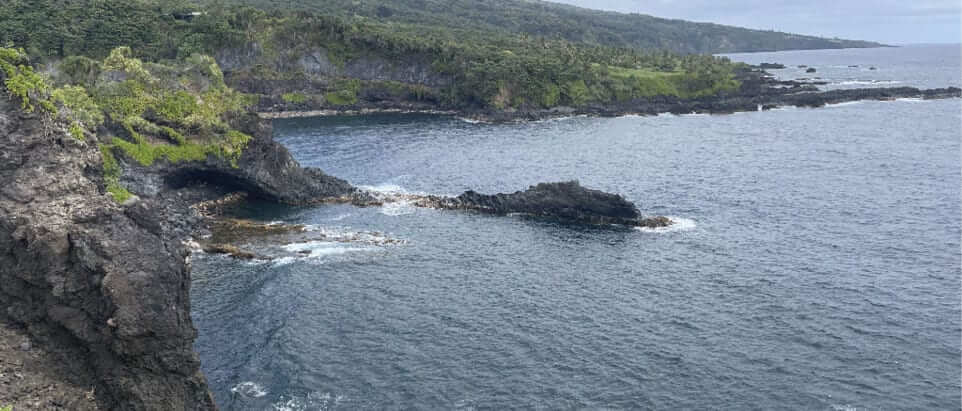
More than a decade after declaring its intent, the community of Kīpahulu, Maui, is on the cusp of becoming Hawaiʻi’s next Community Based Subsistence Fishing Area (CBSFA). Advocates say communities such as Kīpahulu are leading the way toward better governance over natural resources.
“We are grateful that our proposed designation is moving forward and that DLNR (Department of Land and Natural Resources) recognizes that one entity cannot effectively manage all of Hawaiʻi’s resources, but rather it should be done in tandem with community co-stewardship across the pae ʻāina so long as the community supports it,” said Kamalei Pico, who has lineal ties to the area through her maternal grandparents.
Pico took over as executive director for Kīpahulu ‘Ohana in April 2023 after more than 10 years as a volunteer, succeeding Scott Crawford who served as director for more than 20 years. The organization was founded by John and Tweetie Lind.
Kīpahulu sought designation after noticing a significant increase in recreational and commercial fishermen engaging in unsustainable harvests, Pico said. “We could see right before us that our resources were in decline and our community needed to work toward addressing the issues and come up with meaningful solutions.”
On June 23, the Board of Land and Natural Resources unanimously approved the community’s request for a public hearing on the designation. The public hearing is tentatively scheduled for September. In the meantime, Pico said Kīpahulu ‘Ohana scheduled a Makai Watch Training in August, in preparation for CBSFA implementation.
“CBSFAs may not be for all communities, but a CBSFA for our community is the right fit to protect our subsistence lifestyle, traditions, resources, and legacy,” Pico said. “It is a designation we’ve chosen and a space that would allow for ample fishing to feed ‘ohana now and into the future, with places set aside to rest and replenish the ice box.”
Kīpahulu is the latest, but not the only, community to seek a pathway toward self-governance guided by traditional practices and customs. There are CBSFAs at Miloliʻi on Hawaiʻi Island and Hāena on Kauaʻi.
Miloliʻi gained its designation as a CBSFA in 2005. However, the rules governing fishing for the area did not become law until August 2022. Though the process was long, Uʻilani Naipo, a lineal descendant of Miloliʻi, said these traditional practices needed to be “understood, framed and navigated” into the proposed rules.
“There are vessels of knowledge that we’re responsible for. Not just the ʻike itself, not just the names, not just the stories, but the actual traditional practice itself in this landscape. Sometimes we don’t realize that knowledge lives in the landscape itself,” said Naipo. “We can’t talk about fishing without [actually] fishing. Ma ka hana ka ʻike (Through doing one learns). We can’t talk about ōpelu fishing without having the skill set and knowing how the ʻupena (net) is made, how it is used, how to hānai (raise) ʻōpelu.”
The long lag between designation and rule adoption, which was a challenge for both Miloliʻi and Kīpahulu, highlighted much needed improvements to the process of establishing governance of CBSFAs.
“The biggest challenge we feel is that the process took extremely long. We started this process in 2010 and fast forward to 2023, we are ‘almost there,’” said Pico. Keeping the community engaged proved difficult though not impossible she said.
Another challenge has been learning to work across different frameworks, Naipo said. “DAR (the Division of Aquatic Resources) didn’t have a lot of experience on how to work with communities like ours,” she said. “They have a Western framework and we have a cultural framework.”
Things seemingly as straightforward as data collection became a challenge. Traditionally, kilo (observation) is the primary method of data collection and retained through generational learning passed down in the practice.
Part of Naipo’s kuleana was to get local fishermen the credit they deserved, to help others understand the depth of knowledge held by Miloliʻi’s fifth and sixth generation ‘ōpelu fishermen. “The best way I can explain that is the tradition is so paʻa (solid) here,” she said. Her advocacy work includes telling their story.
Naipo said she can see at least two ways to improve the governance of CBSFAs. One is to grant co-managers specific privileges so that they can monitor the health of their CBSFA. “An example of this would be Special Access Permits, related and translated directly from our ruleset for managed species list. This would give the state-recognized co-manager flexibility in monitoring the health of the fisheries,” she said.
The second is to provide training and recruitment of local community members to perform their management responsibilities.
In 1994, lawmakers passed legislation that gave DLNR the authority to create CBSFAs for the “purpose of protecting and reaffirming fishing practices customarily and traditionally exercised for purposes of Native Hawaiian subsistence, culture and religion.”
Kevin Chang, executive director of Kua ʻĀina Ulu ʻAuamo, a nonprofit organization which advocates for community-based resource management and provides support to the communities taking on this work, said: “Government doesn’t have a good way of working with its citizens. (The CBSFA law) moves the government to do that.”
But while the law creates a framework for co-management, it does not clearly define the responsibilities of those involved. “The communities are beginning to define the kuleana they can take on because they have been taking it on, in spite of the government,” said Chang. “We need to better define rights and responsibilities and increase capacity and accountability on both the community and the government side.
“We also need more funding to support community efforts. Right now, it’s all voluntary. I think the bigger goal is to develop a leg of our economy that upholds the health of the environment.”